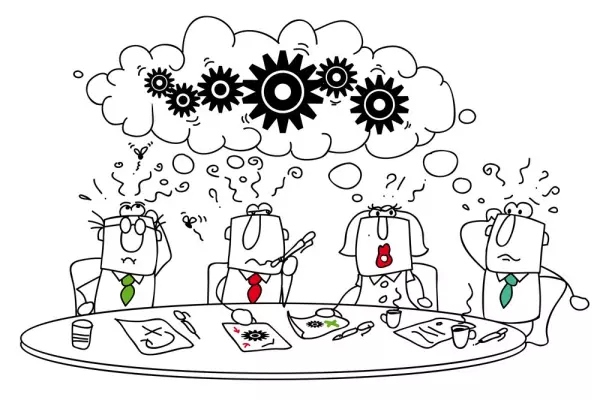Experiments are more associated with science than with business. But just as science seeks to formulate a hypothesis, test, adapt, and then test again, so too should businesses.
The old way of coming up with a plan, and then rolling it out to your organisation is dead. The new ways of working do the opposite: taking ideas from the edges of the organisation, not the top, being bold about adopting them but also about dropping them, and accepting that the plan is never finished. Changing the plan is the plan.
Work is killing us
It’s official, work is literally killing us. Employee engagement is dire. Leaders in every industry tell us about the multitude of problems they’re facing within their organisations. They want to find ways to (*takes deep breath*) speed up, innovate, focus, make better decisions, waste less time, break down silos, plus attract and retain talent. The old ways aren’t working in the new world.
And why? Because today’s corporate norms are based on a model of work created during the second industrial revolution. It was designed for male workers on factory line floors, where people and processes fit together like an engine. The activity was functional, predictable and could be controlled.
But today’s organisations are often much less predictable, as is, of course, the world at large. When the world is changing this fast, we need different tools from those that served us in a more stable era.
Organisations are more complex, emergent and adaptive; they’re likely to surprise and confound us. They need a completely different metaphor: think garden, not engine.
A 'test and learn approach' works better
These complex, garden-like systems ask businesses to “tune in” to the needs of their teams and their environment so they can have rapid and targeted responses to change.
Forget a watered-down, one-size-fits-all approach that tries to be everything to everyone, or a fixed "project plan" that must be delivered according to milestones no matter what happens.
Instead, localised experimentation lets us approach challenges in a variety of contexts in a variety of ways. It encourages ownership of a change at the edges, where the team experiencing the challenge first-hand is in charge of solving it.
An experimental mindset sets them up to succeed, sensing and responding as they go, quickly figuring out what works, where it works, and how to adapt if and when it stops working.
Why it’s hard
But experimentation – the process and the word itself – can be perplexing to leaders. Some react negatively to the concept because it feels temporary, long-winded, unproven and risky.
Much of this response is down to the way our brains work. The status quo is very comfortable – it feels nice!
I often hear that people are afraid of change, but that’s not quite it: in fact, they’re afraid of loss – of losing mastery over a process, over a way of working that has served them for a long time, even if it no longer does.
Experimenting with something new feels like inviting failure, rather than exploring the possibility.
The solution
Though this suspicion is natural, it’s not insurmountable. If you recognise that it’s time to make some changes in your own organisation, here are five principles and practices that will add some certainty to the process and reassure your colleagues that you’re not in uncharted waters.
The world’s top businesses have already made these changes – the greatest risk is that your competitors will get there before you do.
1. Start small, start narrow
When they're experimenting, people often try to change many things at once. Instead, focus the experiment on one practice to try – such as one meeting type, or one new workflow.
A good experiment has a concrete, clear, measurable outcome. Ask yourself: How will we know if it’s been successful? What are we looking for? How will we know if it was beneficial or harmful?
I’ve heard leaders suggest an experiment isn’t bold enough. “When making a change to our onboarding process, why not also redesign our training offerings, our recruitment policies and the way we allocate budget while we’re at it?”
But it’s just not a good idea to make several changes at the same time. Because of the inherent complexity, it’s impossible to accurately measure and evaluate what will unfold. This can leave you with a lot of unsettling change and no significant results to show for it.
2. Devolve your decision making
Your goal is to make work better for everyone, so when you're designing your experiments, it’s essential to involve people from across a variety of functions, geographies, and demographics.
Unfortunately, most leaders fail to do this. More than two-thirds of executives said they designed their post-pandemic workforce policies with little to no direct input from employees.
Start by forming a working group made up of a diverse and representative range of employees who can offer perspectives, test new ways of working, share best practices, and help shape the path forward.
This will inspire the commitment, ownership, and perspective to engage with it.
3. Choose the right duration
Ask yourself: How long will it take to have learned something from this experiment?
Some experiments will be short. You could try taking the bus instead of the car to work four days in a row, and by day five be able to draw some conclusions.
But trying to lose weight by taking a walk each morning before breakfast will require weeks before you can get the information you need. Choose the right horse for your course.
The best experiments leave ample time for repetitions and persevering through the dip of unlearning and discomfort. A good rule of thumb is to stick with the experiment a bit longer than you think you need to.
4. Make time for retrospectives
To get insights and learn from your experiment, do 'retrospectives' at regular intervals. Try these meetings to review how things are going once a fortnight as a good place to start. Even if you’re confident you know everything that’s going on and you think a retro won’t provide anything of note, do it anyway.
It will often prompt things that you haven’t yet thought about.
Fold the lessons you learn into actions you will take in the next iteration of the experiment. Rinse and repeat.
5. Fly the flag for failure
A culture of learning needs room to fail. But it’s unrealistic to think that, without your encouragement and modelling, your employees will feel free to try new things and make mistakes.
Acknowledge when an employee learns something new or changes how they do something. Elevate their success. Get people excited about learning new things and recognise the effort of employees to be perpetual learners.
Recognise them in a group meeting, send an appreciative note, or invite them to teach others. No matter how big or small, celebrate the success of continuously learning.
Remember, successful experimentation means, “We learned something useful,” not “It did what we hoped it would do.”
Where is the finish line?
Sadly, there’s no one-size-fits-all advice to help with the unique challenges of your industry and workforce. That’s the point of experimentation – it helps you figure out what’s going to work for your teams and your organisation specifically.
Then, as we’ve learnt over the past few years, just when you think you have the playing field covered, the goal posts shift once again.
That’s why there is no “done” when creating a better way of working. You’re never done experimenting. You’re never done learning. And you’re never done communicating with people about what you’re aiming for and how it’s going.
This makes good business sense in any change management effort, but it’s worth a reminder here because we all tend to lose energy and focus as time passes.
So, don’t expend too much energy working out when the changes will be complete. The world’s most successful leaders are not only embracing the experimentation culture but also setting systems in place to encourage continual evaluation, evolution and improvement.
Though it emerged in times of crisis, this new way of working is here to stay for one simple business reason: it provides a competitive advantage to those organisations willing to embrace it.














